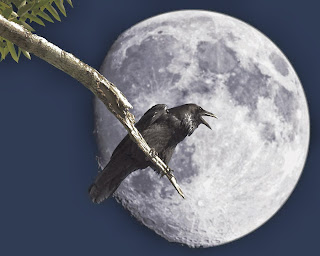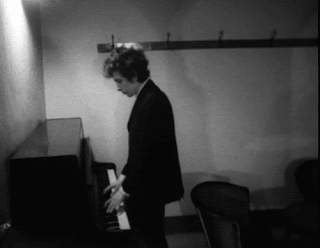Mark Brown, arts correspondent
The Guardian, Tuesday 24 September 2013 16.13 BST
Bob Dylan works on one of his iron gates, which will feature in the Halcyon gallery's Mood Swings exhibition. Photograph: John Shearer/Rebecca Ward/PA
Come writers and critics who prophesise with your pen and keep your eyes wide … because Bob Dylan is welding gates.
The Halcyon gallery in London has announced plans to exhibit ironworks designed and made by the musician as he continues his career reinvention as an exhibiting visual artist.
Seven iron gates Dylan has welded out of vintage iron and objects including a wrench, roller skate, meat grinder and lawn tools, will go on display for the first time, in an exhibition opening in November, alongside his paintings and signed limited editions.
Dylan said: "I've been around iron all my life ever since I was a kid. I was born and raised in iron ore country where you could breathe it and smell it every day. And I've always worked with it in one form or another.
"Gates appeal to me because of the negative space they allow. They can be closed but at the same time they allow the seasons and breezes to enter and flow. They can shut you out or shut you in. And in some ways there is no difference."
Dylan would say he has been a visual artist most of his life but it is only in the past six years that he has been exhibiting and selling work. His first museum show was staged in Chemnitz, Germany, in 2007.
He has had success and the National Portrait Gallery is at the moment showing 12 pastel portraits of his in a small display which will stay until January.
The Halcyon's forthcoming show, entitled Mood Swings, will "be the most comprehensive and authoritative collection of Bob Dylan's art to date", said the gallery's director, Paul Green.
Green added: "While Dylan has been a committed visual artist for more than four decades, this exhibition will cast new light on one of the world's most important and influential cultural figures of our time. His iron works demonstrate his boundless creativity and talent."
Of war and peace the truth just twists
Its curfew gull just glides
Upon four-legged forest clouds
The cowboy angel rides
With his candle lit into the sun
Though its glow is waxed in black
All except when ’neath the trees of Eden
Its curfew gull just glides
Upon four-legged forest clouds
The cowboy angel rides
With his candle lit into the sun
Though its glow is waxed in black
All except when ’neath the trees of Eden
The lamppost stands with folded arms
Its iron claws attached
To curbs ’neath holes where babies wail
Though it shadows metal badge
All and all can only fall
With a crashing but meaningless blow
No sound ever comes from the Gates of Eden
Its iron claws attached
To curbs ’neath holes where babies wail
Though it shadows metal badge
All and all can only fall
With a crashing but meaningless blow
No sound ever comes from the Gates of Eden
The savage soldier sticks his head in sand
And then complains
Unto the shoeless hunter who’s gone deaf
But still remains
Upon the beach where hound dogs bay
At ships with tattooed sails
Heading for the Gates of Eden
And then complains
Unto the shoeless hunter who’s gone deaf
But still remains
Upon the beach where hound dogs bay
At ships with tattooed sails
Heading for the Gates of Eden
With a time-rusted compass blade
Aladdin and his lamp
Sits with Utopian hermit monks
Sidesaddle on the Golden Calf
And on their promises of paradise
You will not hear a laugh
All except inside the Gates of Eden
Aladdin and his lamp
Sits with Utopian hermit monks
Sidesaddle on the Golden Calf
And on their promises of paradise
You will not hear a laugh
All except inside the Gates of Eden
Relationships of ownership
They whisper in the wings
To those condemned to act accordingly
And wait for succeeding kings
And I try to harmonize with songs
The lonesome sparrow sings
There are no kings inside the Gates of Eden
The motorcycle black madonna
Two-wheeled gypsy queen
And her silver-studded phantom cause
The gray flannel dwarf to scream
As he weeps to wicked birds of prey
Who pick up on his bread crumb sins
And there are no sins inside the Gates of Eden
Two-wheeled gypsy queen
And her silver-studded phantom cause
The gray flannel dwarf to scream
As he weeps to wicked birds of prey
Who pick up on his bread crumb sins
And there are no sins inside the Gates of Eden
The kingdoms of Experience
In the precious wind they rot
While paupers change possessions
Each one wishing for what the other has got
And the princess and the prince
Discuss what’s real and what is not
It doesn’t matter inside the Gates of Eden
In the precious wind they rot
While paupers change possessions
Each one wishing for what the other has got
And the princess and the prince
Discuss what’s real and what is not
It doesn’t matter inside the Gates of Eden
The foreign sun, it squints upon
A bed that is never mine
As friends and other strangers
From their fates try to resign
Leaving men wholly, totally free
To do anything they wish to do but die
And there are no trials inside the Gates of Eden
A bed that is never mine
As friends and other strangers
From their fates try to resign
Leaving men wholly, totally free
To do anything they wish to do but die
And there are no trials inside the Gates of Eden
At dawn my lover comes to me
And tells me of her dreams
With no attempts to shovel the glimpse
Into the ditch of what each one means
At times I think there are no words
But these to tell what’s true
And there are no truths outside the Gates of Eden
And tells me of her dreams
With no attempts to shovel the glimpse
Into the ditch of what each one means
At times I think there are no words
But these to tell what’s true
And there are no truths outside the Gates of Eden
http://margaretgunnng.blogspot.ca/2013/04/the-glass-character-synopsis.html
















